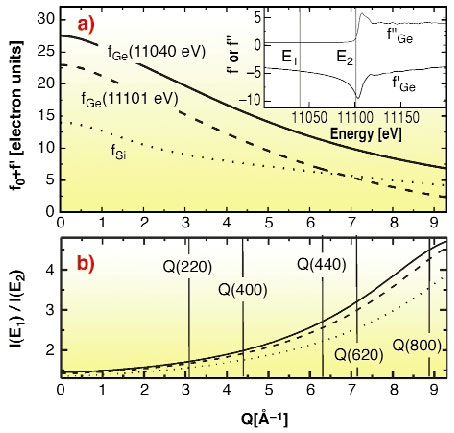- Home
- Users & Science
- Scientific Documentation
- ESRF Highlights
- ESRF Highlights 2003
- Surface and Interface Science
- Direct Determination of Strain and Composition Profiles in SiGe Island
Direct Determination of Strain and Composition Profiles in SiGe Island
Anomalous X-ray scattering at beamline ID01 is employed for quantitative measurements of the Ge composition profile in islands on Si(001). Comparing the intensity ratios for X-ray energies below and close to the K edge of Ge at various Bragg reflections in the grazing-incidence diffraction setup, the sensitivity for the Ge profile is considerably enhanced at high momentum transfer. The method is demonstrated for SiGe dome-shaped islands grown on Si(001). It is found that the composition inside the island changes rather abruptly at the substrate interface whereas the lattice parameter relaxes continuously.
Ge islands on Si have been the subjects of numerous studies. Such islands show interesting morphological shape transitions as a function of growth parameters. From a series of studies, it is known that intermixing in such islands exists, but difficulties in the quantification of the composition profile along the growth direction remain. This profile, together with the strain distribution is of fundamental importance for the electronic band structure of embedded islands and thus for any application. Anomalous X-ray diffraction close to absorption edges can indeed be used to obtain the necessary chemical sensitivity for a direct determination of composition profiles in SiGe islands. In general, the energy and momentum dependency of the atomic scattering factor is expressed by f(Q,E) = f0(Q) + f'(E)+if"(E). With f'(E) and f"(E) being the energy-dependent correction that becomes important close to an absorption edge. f0 equals the total number of electrons Z for forward scattering, but decreases for higher momentum transfer Q. Thus the anomalous scattering effects can be enhanced considerably by measuring Bragg reflections for high momentum transfers as shown in Figure 89, since f'(E) and f"(E) remain constant with Q. Evaluating the intensity ratio for the two energies E1 and E2 (inset in Figure 89a) at a given momentum transfer Q, one can link composition and lattice parameter without any model assumptions. To demonstrate the method, a SiGe island sample grown by molecular beam epitaxy on Si(001) has been investigated.
 |
|
Fig. 89: (a) Momentum dependence of the scattering factors of Si (dotted line) and Ge for the two energies E1 and E2 (full and dashed line). Inset: anomalous corrections f' and f" for Ge in the vicinity of the K-absorption edge. (b) Theoretical momentum dependence of the ratio of the diffracted intensities at E1 = 11043 eV and E2 = 11103 eV for pure Ge (solid line), Si0.1Ge0.9 (dashed line) and Si0.3Ge0.7 (dotted line). |
At a substrate temperature of 600ºC, seven monolayers of Ge were deposited, leading to islands with a height of about 140 Å and a width at the base of about 700 Å. From the intensity ratios I(E1)/I(E2) of the most sensitive reflections (620) and (800) the composition for a certain lattice parameter is directly extracted. A region with vanishing Ge-content exhibiting tensile strain with respect to the substrate is clearly visible. This can be attributed to the strained region in the Si-substrate below the Ge-island. In a second step, we recorded line-scans perpendicular to the radial scan direction. These angular scans are sensitive to the lateral size of a region with fixed lattice parameter. Using the cross-section profile of the islands from atomic force microscopy, the lateral size can be associated with a certain height within the islands (see horizontal lines in Figure 90a), linking the height with the in-plane momentum transfer Q. Combining all results we can finally reconstruct the Ge-concentration as a function of the height in the island. The result is shown in Figure 90b. The figure clearly shows a rather abrupt interface between Si and the SiGe-island, with an almost constant Ge content of roughly 80% above a height of 20 Å.
 |
|
Fig. 90: (a) Cross-section profile of one dot extracted from the AFM data. The lateral size (solid straight lines) as determined from the angular scans can be attributed to a certain height. (b) The relaxation (black squares) |
Principal Publication and Authors
T.U. Schülli (a,b), J. Stangl (a), Z. Zhong (a), R.T. Lechner (a), M. Sztucki (b), T.H. Metzger (b), G. Bauer (a), Phys. Rev. Lett. 90, 066105 (2003).
(a) Johannes Kepler University Linz (Austria)
(b) ESRF



